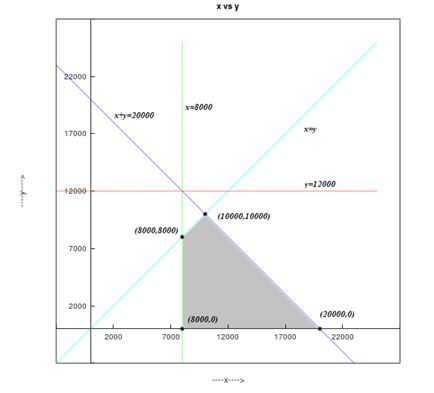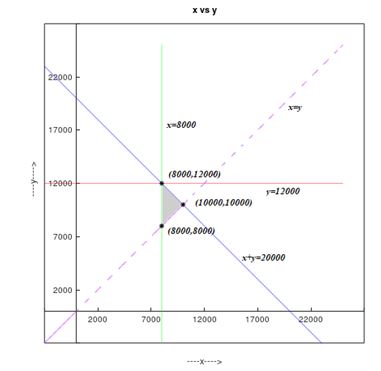
Concept explainers
Return on Investment An investment broker is instructed by her client to invest up to , some in a junk bond yielding per annum and some in Treasury bills yielding per annum. The client wants to invest at least in T-bills and no more than in the junk bond.
(a) How much should the broker recommend that the client place in each investment to maximize income if the client insists that the amount invested in T-bills must equal or exceed the amount placed in the junk bond?
(b) How much should the broker recommend that the client place in each investment to maximize income if the client insists that the amount invested in T-bills must not exceed the amount placed in the junk bond?
To solve: The given linear programming problem.
Answer to Problem 23AYU
Solution:
a. The maximum return on investment is , when is invested in T-Bills and is invested in junk bond.
Explanation of Solution
Given:
- Total investment upto .
- Minimum investment in Treasury Bills .
- Maximum investment in junk bond .
- Interest from Treasury Bills .
- Interest from junk bond .
Calculation:
Begin by assigning symbols for the two variables.
Amount invested in T-Bills.
Amount invested in junk bond.
a. If is the total return from both the investment, then
The goal is to maximize subject to certain constraints on and . Because and represents the amount, the only meaningful values of and are non-negative.
Therefore, .
From the given data we get
Therefore, the linear programming problem may be stated as
Maximize
Subject to
The graph of the constraints is illustrated in the figure below.

| Corner points are | Value of objective function |
The maximum return on investment is , when is invested in T-Bills and is invested in junk bond.
To solve: The given linear programming problem.
Answer to Problem 23AYU
Solution:
b. The maximum return on investment is , when is invested in T-Bills and is invested in junk bond.
Explanation of Solution
Given:
- Total investment upto .
- Minimum investment in Treasury Bills .
- Maximum investment in junk bond .
- Interest from Treasury Bills .
- Interest from junk bond .
Calculation:
Begin by assigning symbols for the two variables.
Amount invested in T-Bills.
Amount invested in junk bond.
b. If is the total return from both the investment, then
The goal is to maximize subject to certain constraints on and . Because and represents the amount, the only meaningful values of and are non-negative.
Therefore, .
From the given data we get
Therefore, the linear programming problem may be stated as
Maximize
Subject to
The graph of the constraints is illustrated in the figure below.

| Corner points are | Value of objective function |
The maximum return on investment is , when is invested in T-Bills and is invested in junk bond.
Chapter 11 Solutions
Precalculus Enhanced with Graphing Utilities
Additional Math Textbook Solutions
Calculus, Single Variable: Early Transcendentals (3rd Edition)
Calculus: Early Transcendentals (3rd Edition)
Single Variable Calculus: Early Transcendentals (2nd Edition) - Standalone book
University Calculus: Early Transcendentals (4th Edition)
Glencoe Math Accelerated, Student Edition
Precalculus: Concepts Through Functions, A Unit Circle Approach to Trigonometry (4th Edition)
 Calculus: Early TranscendentalsCalculusISBN:9781285741550Author:James StewartPublisher:Cengage Learning
Calculus: Early TranscendentalsCalculusISBN:9781285741550Author:James StewartPublisher:Cengage Learning Thomas' Calculus (14th Edition)CalculusISBN:9780134438986Author:Joel R. Hass, Christopher E. Heil, Maurice D. WeirPublisher:PEARSON
Thomas' Calculus (14th Edition)CalculusISBN:9780134438986Author:Joel R. Hass, Christopher E. Heil, Maurice D. WeirPublisher:PEARSON Calculus: Early Transcendentals (3rd Edition)CalculusISBN:9780134763644Author:William L. Briggs, Lyle Cochran, Bernard Gillett, Eric SchulzPublisher:PEARSON
Calculus: Early Transcendentals (3rd Edition)CalculusISBN:9780134763644Author:William L. Briggs, Lyle Cochran, Bernard Gillett, Eric SchulzPublisher:PEARSON Calculus: Early TranscendentalsCalculusISBN:9781319050740Author:Jon Rogawski, Colin Adams, Robert FranzosaPublisher:W. H. Freeman
Calculus: Early TranscendentalsCalculusISBN:9781319050740Author:Jon Rogawski, Colin Adams, Robert FranzosaPublisher:W. H. Freeman
 Calculus: Early Transcendental FunctionsCalculusISBN:9781337552516Author:Ron Larson, Bruce H. EdwardsPublisher:Cengage Learning
Calculus: Early Transcendental FunctionsCalculusISBN:9781337552516Author:Ron Larson, Bruce H. EdwardsPublisher:Cengage Learning





